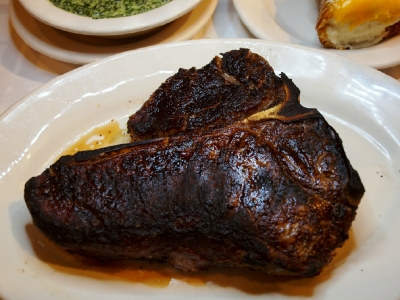[dropcap1]Q. [/dropcap1]What exactly is the difference between dry-aged beef and whatever is the opposite of dry-aged beef?
[dropcap1]A. [/dropcap1]After almost disappearing from the New Orleans steakhouse scene, dry-aged beef is currently staging a comeback, with a few new restaurants making a fuss over it. Dry-aging involves storing whole beef roasts (New York strip roasts, porterhouses, and rib-eyes, mostly) in a refrigerator. The beef is exposed to the air inside the refrigerator the whole time. After two to four weeks, the outside of the beef becomes dark and hard. Sometimes a mold even grows on it. When the butcher deems it ready, he slices off the exterior eighth of an inch or so, cuts it into steaks, and it's ready for the broiler.
The advantages of dry-aging are that the flavors of the beef are concentrated, and the aging process itself adds a flavor that connoisseurs find delectable. On the other hand, many people find that same flavor suggestive of spoilage. That's one of the disadvantages of dry-aging. So is the way that dry-aged beef loses a significant amount of weight, and so becomes more expensive to serve.
At the moment, the restaurants serving dry-aged beef are the Crescent City Steak House, Delmonico, and Doris Metropolitan. Ruth's Chris and Morton's used to dry-age, but no longer do.
[caption id="attachment_24645" align="alignnone" width="400"] Aged porterhouse[/caption]
Wet-aging is, in my opinion, not aging at all. The beef roasts are kept in the vacuum plastic wrapper, under refrigeration, for as much as six weeks. They become tenderer, but there's no noticeable change in the flavor. Which will seem an advantage to those who prefer fresh-tasting beef. But to me it's nothing special.
And then, of course, you have beef that isn't aged at all. Tenderloins (whence comes filet mignon and tournedos) are not aged aged. That is not a defect, but a preference.
But I prefer USDA Prime, dry-aged sirloin strips.
Aged porterhouse[/caption]
Wet-aging is, in my opinion, not aging at all. The beef roasts are kept in the vacuum plastic wrapper, under refrigeration, for as much as six weeks. They become tenderer, but there's no noticeable change in the flavor. Which will seem an advantage to those who prefer fresh-tasting beef. But to me it's nothing special.
And then, of course, you have beef that isn't aged at all. Tenderloins (whence comes filet mignon and tournedos) are not aged aged. That is not a defect, but a preference.
But I prefer USDA Prime, dry-aged sirloin strips.
Written by Tom Fitzmorris July 18, 2014 11:01 in